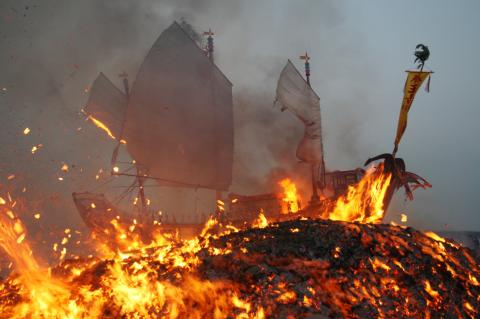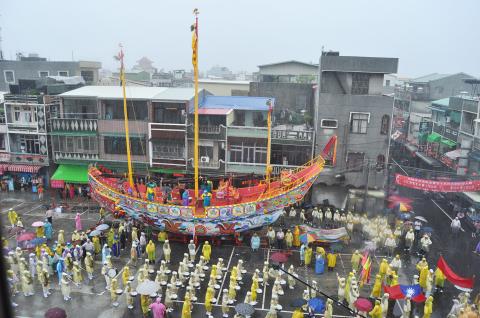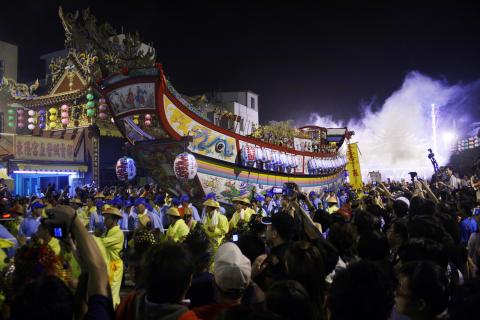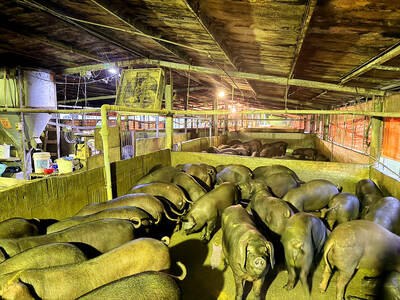Jin Luan Gong, a temple in Greater Kaohsiung’s Cieding District, finished building a ship that was used in a plague offering ceremony for the Wang Yeh plague gods on May 20. Excluding the mast, but including the area from the bottom of the ship to the hatch, the ship is 21.21m long, 4.24m wide, and 1.76m tall. The total amount spent on the ship exceeded NT$10 million, including money spent on items placed on it. The ship is the biggest Wang Yeh ship ever built in southern Taiwan.
The worship of Wang Yeh is quite prevalent in the Cieding area, and a ship, which is eventually burned, has to be built every time a plague offering ceremony is held to see the gods off. These ceremonies are usually held every 12 years at Jin Luan Gong, which was constructed over 300 years ago.
Kuo Chin-cheng, chairman of the temple’s plague offering committee, says last year the sea goddess Matsu expressed that a ceremony for Wang Yeh needed to be held, so the temple followed tradition and held a divination ceremony, hung up ceremonial lanterns, and enshrined a statue of Wang Yeh. The Wang Yeh ship’s keel is 6.24m long, 66cm wide, and 61cm thick. Su Chun-fa, a master Wang Yeh shipbuilder, was hired to build the ship.

Photo: Perry Svensson, Taipei Times
照片:台北時報記者Perry Svensson
After graduating from elementary school, the now 69-year-old Su became a wooden shipbuilder’s apprentice in Cieding’s Baishalun fishing harbor, but the number of fishing boats sharply decreased as ocean resources continue to dwindle, so at the age of 28 Su decided to learn how to build Wang Yeh ships with a master Wang Yeh shipbuilder. He has made a total of 80 Wang Yeh ships over the past 41 years.
Su says the size of a Wang Yeh ship depends on the length of the keel, but where are keels obtained and how big are they supposed to be? Su says whatever Matsu or Wang Yeh say goes, so in the past keels were traditionally selected by practitioners as they carried deities on palanquins to select the wood. Today, however, materials for building them are obtained directly from wood factories.
After half a year of detailed and meticulous carving, the huge Wang Yeh ship was finally able to leave the factory on May 20, and although it was raining heavily that day, worshippers still enthusiastically showed up in great numbers for the ceremony.

Photo: Su Fu-nan, Liberty Times
照片:自由時報記者蘇福男
Hsueh Chao-hsuan, head of the temple’s department of general affairs, says that the large ship cost more than NT$5 million, but after adding 200 various items to the boat, including a TV, a refrigerator, and an ancient cannon, the overall cost exceeded NT$10 million. The ritual ceremony for seeing off the Wang Yeh gods is scheduled to be held on June 16.
Su says that Wang Yeh ships and wooden fishing boats are built in exactly the same way and that they are actually capable of sailing on water. This particular ship contains a Matsu floor, a Wang Yeh court, a prison below deck and separate toilets for men and women.
(Liberty Times, Translated by Kyle Jeffcoat)
高市茄萣區金鑾宮為建醮活動打造的大王船五月二十日為瘟神王爺完工出廠,王船長二十一點二一公尺、寬四點二四公尺、高一點七六公尺,不含船桅,船底到水艙門的高度,連同添載物品價逾上千萬元,為南台灣歷年來最大艘王船。

Photo: Perry Svensson, Taipei Times
照片:台北時報記者Perry Svensson
茄萣地區王爺信仰盛行,每次建醮活動必定舉行送王(燒王船)儀式,有三百多年歷史的金鑾宮,平均每十二年舉辦一次王醮盛典。
金鑾宮建醮委員會主委郭進成表示,去年媽祖婆指示要辦王醮,廟方依例進行卜主會、豎燈篙、親王開光等前置作業。此次王船龍骨長六點二四公尺、寬六十六公分、厚六十一公分,禮聘王船大師蘇春發打造。
六十九歲的蘇春發,國小畢業就在茄萣白砂崙漁港當木製漁船學徒,由於海洋資源日漸枯竭,漁船數量銳減,廿八歲轉向澎湖師傅拜師學習王船工藝,四十一年來,已打造出八十艘王船。
蘇春發表示,王船大小取決於龍骨長度,到哪裡選取?尺寸要裁多少?媽祖婆、王爺公「說了算」,昔日取龍骨多由信眾抬著神明轎外出尋找,當今多改為直接到木材工廠選材。
歷經半年的精雕細琢,大王船五月二十日上午出廠,雖然下著大雨,但信眾熱情不減,陣頭輪番上陣向王船「拜旗」致敬。
總務組長薛兆軒表示,大王船造價逾五百萬元,船上將另添載二百多項用品,包括電視、冰箱、古戰船大砲等,總價達上千萬元。送王儀式預計六月十六日舉行。
蘇春發表示,大王船完全比照木製漁船手工打造,可以在海上航行,船上設有媽祖樓、王爺府,底下還有監獄,連廁所都有男女之分。
(自由時報記者蘇福男)

For many people in Taiwan, childhood memories of rural life include pig pens standing beside family homes. Leftover rice, vegetable scraps and soup from daily meals were poured into buckets and fed to pigs. This practice of feeding pigs with household food waste was once a common way of life, both an economic choice and an expression of agricultural society’s deep respect for conserving resources. From a practical standpoint, pigs are omnivorous animals capable of efficiently digesting food scraps that humans can no longer eat. For rural households, food waste cost almost nothing, yet it could be converted into pork, a

Tango unfolds in a dimly lit room, where a haunting melody ushers two dancers into a close embrace. Here, music and movement merge into a silent yet passionate conversation, expressing longing, memory and shared purpose. What makes tango truly magical is the deep interaction and spontaneous improvisation between partners. Tango began in the late 19th century in Buenos Aires, Argentina’s bustling capital. Born in the poor working-class neighborhoods and busy port areas, this dance emerged from a melting pot of cultures. European immigrants, African slaves and local residents all contributed to its unique character. From these rich influences, tango

A: What show are you watching online? B: I’m watching “Fly Me to the Moon & Back” – an exhibition launched by the Taipei Music Center (TMC) to commemorate the late singer Tom Chang. A: Known for his sky-high notes, Chang is praised as one of the best singers in the 1990s. His death at the age of 31 was a major loss indeed. B: And I’m so glad that we went to the TMC’s 90s-themed concert last Friday. I finally saw the iconic “Godmother of Rock” WaWa perform live. A: This year-end show also featured singers Princess Ai, Bii, Wayne Huang, PoLin and

Continued from yesterday(延續自昨日) https://www.taipeitimes.com/News/lang The loss of sea stars significantly impacts the ocean ecosystem. Sea stars are important __6__ that help control populations of mussels and sea urchins. Among them, the sunflower star is one of the largest and fastest sea stars and is adept at preying on sea urchins. Without sea stars, sea urchins can __7__ in numbers and devastate kelp forests. These forests are essential __8__ for many marine animals and also help capture carbon from the atmosphere, which is vital in the fight against climate change. The mystery behind SSWD is still __9__, but it is clear that